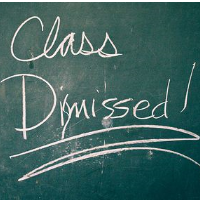State Education Officials Agree: Fake Classes Must Go
 (photo: Orin Zebest, via Flickr)
(photo: Orin Zebest, via Flickr)
Yes, California needed a law to make it clear to cash-strapped school districts that disadvantaged high school students can’t be stuffed into fake classes lacking any kind of content―and now a lawsuit to convince the state to make sure it happens.
The State Board of Education settled Cruz v. State of California last week, agreeing to provide immediate help to six school districts where students sued over their lack of instructional time, especially in classes needed to graduate and/or get into college. They were represented by the American Civil Liberties Union of Southern California (ACLU) and the pro bono law firm Public Counsel.
The class-action lawsuit, filed in May 2014, alleged that students in some Los Angeles County and Oakland schools attended sham classes, slogged through make-work assignments, performed menial tasks, ran errands for teachers and went home early. The schools are in disadvantaged, mostly minority areas. The settlement’s effect is expected to be widespread.
The suit said that denial of basic services and an equal education violated the California Constitution. “These deprivations conspire to convey to students and inescapable message that the time they spend in school is not valuable,” the complaint said.
The lawsuit pointed out this is nothing new or unknown. “The State is aware and has been aware for years that students at these schools are systematically deprived of meaningful learning time.”
The state Department of Education agreed to help the six schools with any problems they incur that prevent them from ditching the fake classes and scheduling kids for the proper ones. The state will monitor school districts’ course enrollment data for two years and also picked up $400,000 in attorneys fees for the plaintiffs.
Arguably the most egregious case among the schools was Thomas Jefferson High in Los Angeles. Alameda County Superior Court Judge George Hernandez Jr. decided not to wait for the class-action suit to be resolved when he ruled in October 2014 that the school was in distress and the state needed to help them. The state argued that it was the responsibility of school districts to deal with instructional shortcomings, like fake classes, but the judge disagreed.
Afterward, then-Los Angeles Unified School District (LAUSD) Superintendent John Deasy agreed with the judge. “These ‘classes’ are not designed to deliver real instruction or learning opportunities to students, but rather are no more than fillers to plug gaps where no genuine courses are readily available,” he wrote.
The Cruz settlement must be approved by a judge. It almost certainly will not result in equal education services and resources in all schools, regardless of their community’s wealth.
–Ken Broder
To Learn More:
State Settles Lawsuit over "Fake" Classes (by Fermin Leal, EdSource)
California Officials Agree to Stop Schools from Assigning Students to “Fake Classes” (by Emma Brown, Washington Post)
Settlement Seeks to Keep High School Students out of “Fake” Classes (by Joy Resmovits, Los Angeles Times)
Judge Orders State to Fix L.A. High School Now, as He Ponders Larger Educational Decrepitude (by Ken Broder, AllGov California)
Cruz v. State of California (Complaint in Alameda County Superior Court) (pdf)
- Top Stories
- Controversies
- Where is the Money Going?
- California and the Nation
- Appointments and Resignations
- Unusual News
- Latest News
- California Forbids U.S. Immigration Agents from Pretending to be Police
- California Lawmakers Urged to Strip “Self-Dealing” Tax Board of Its Duties
- Big Oil’s Grip on California
- Santa Cruz Police See Homeland Security Betrayal in Use of Gang Roundup as Cover for Immigration Raid
- Oil Companies Face Deadline to Stop Polluting California Groundwater





